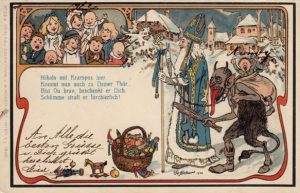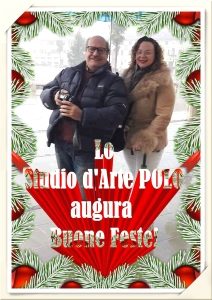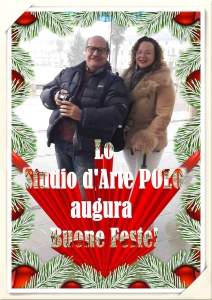“In mutual silence
proceeds observed,
through an almost invented red
and master of fairy tales “***
Christmas is a beautiful party and we too like the Gentile Polo Art Studio to celebrate, but how does the myth of St. Nicholas – Santa Claus?
For those who like the artist, Gentile Polo and I, it is curious to try to tell it!

According to the first written attestations of the Greek monk Michele Archimandrita of 710 d. C. and of the bishop Methodius, Nicholas (in Greek Nikolaos, victorious people) was born in Patara in Turkey around 260 AD. from a wealthy family.
According to tradition, St. Nicholas showed from the childhood the ecclesial gifts of charity, morigeness and chastity.
He moved to Myra (now Bari) and became aware that a nobleman who had fallen into poverty, unable to offer a dowry to his daughters so that they could marry, was about to launch them into prostitution in order to gather the necessary money.
St. Nicholas decided to do a work of charity and in the middle of the night, not wanting to advertise himself, he dropped a bag of gold coins in the window of the poor house. Thanks to the gift received the father of the girls could marry the eldest daughter.
Seeing the poverty of the poor man, Nicholas repeated his good deed as many as his daughters, but on the last night the man managed to chase the benefactor to thank him. Nicola asked to remain anonymous, but his gesture in time was handed down and the young man assumed the current fame in Myra (Bari, Italy) and in the world.
Another episode handed down tells that
three children had nothing to eat, Nicola gave him an apple each. In the night the fruits were transformed, becoming golden.
(in “Why do you give apples to San Nicolò?”, giornaledilecco.it of 06.12.2017)
Hence the tradition in Lecco to give the children also a beautiful red apple and why the saint is iconographically depicted or with three bags / globes of gold, or with three juicy golden apples.
![]()
(Photo: detail of the marble altar of the church of S. Nicolò di Bari all’Albergheria, from terradamare.org dated 28.11.2015)
Finally, legend has it that, after the local bishop died, the assembly of the domus ecclesiae met to elect the successor and one of the gatherings one night had a vision that prophesied the election of the first young man who would go to church at dawn and his name would have been Nikòlaos.
The prophecy came true as in the dream and Nicholas was elected bishop (308 – 314 AD).
Between 303 and 319 d.C. with Diocletian first and Licinius then there were periods of persecution against Christians and the same bishop Nicholas, according to the Byzantine historian Niceforo Callisto, suffered prison and torture.
Constantine brought peace with his Edict of 318 AD, but the ecclesiastical dispute over the divine nature of Christ led the emperor to issue in 325 AD. the Council of Nicea.
During the council a schism was generated, with Bishop Ario on the negationist and intransigent front, Nicholas from the orthodox part of Attanasio, but being conciliatory and driven by the desire to keep united the Church was long condemned to “damnatio memoriae”. (Father Gerardo Cioffari O.P. in basilicasannicola.it)
Despite this it seems that he continued his work of letter and charity towards the poor and the needy until his death, estimated on December 6th of the 335 (even though it remains for many vague between 345 and 352 AD). He was buried in the church of Myra (Demre, Turkey).
The feast of St. Nicholas is celebrated in Italy in Bari and Venice (which for a long time disputed the relics), Molfetta, Trieste, Bolzano, Friuli – Venezia Giulia, Trentino – Alto Adige, Belluno and Sinistra Piave; abroad in Germany, Austria, Switzerland, Liechtestein, France, Belgium, Holland, Estonia and Czech Republic.
It is commemorated in the night between 05 and 06 December, but already from the last week of November the parades of the saint that brings gifts to good children are followed in many areas, followed by the din of the hairy and terrifying devils (Krampus) who try to kidnap the bad ones.

(1900 postcard from Vienna, from bambinietopi.it)
The northern European immigrants brought these legends with them when they founded the first colonies in the New World. Those Dutch, remained fond of St. Nicholas, spread his name, “Sinterklaas”. (by Brian Handwerk in Da San Nicola in Santa Claus – the true story of Santa Claus, nationalgeographic.it dated 24.12.2015)
Before then in America and England Christmas was seen more as a pagan festival where the climax of the party was a massive consumption of alcohol.
In the early 1800s the new idea began to spread:
Already in a book dated 1809, Washington Irving imagined a Nicholas walking on rooftops with his flying chariot carrying presents to good children; then it was the turn of an anonymous book in verse, The Children’s Friend, with the first true appearance of Santa Claus, associated with Christmas “but deprived of any religious characteristic, and dressed in furs typical of the funny bearers of Germanic gifts,” explains Bowler . This Santa brings gifts but also inflicts punishments on bad children, and his chariot is pulled by only one reindeer.
The reindeer become eight and the wagon becomes a sled in the poem A Visit From St. Nicholas, written in 1822 by Clement Clark Moore for his children but immediately became “viral”. For many decades, Santa Claus is represented with various features and clothes of various shapes and colors.
(by Brian Handwerk in Da San Nicola in Santa Claus – the true story of Santa Claus, nationalgeographic.it dated 24.12.2015)
Between the end of the 1800s, with illustrations by the political cartoonist Thomas Nast and The Coca Cola advertisement of 1931 by the illustrator Haddon Sundblom, which brought together the memories of Saint Nicholas and the “spirit of Christmas present” by Charles Dickens (Canto di Christmas) Santa Claus acquires the current connotations, replacing the white or blue robe and the red or yellow surcoat embroidered in gold with red fur tunic and trousers, the miter with a red pom-pom cap.
The advertising image returns to Europe thanks also to the
American soldiers disembarked during the Second World, and the cheerful fat ends up symbolizing the generosity of the US in the reconstruction of Western Europe. (by Brian Handwerk, ibid.)
Santa Claus “back” is celebrated on December 25th.
Catherine Wilkinson, a forensic anthropologist from the University of Manchester, tried to reconstruct her true aspect based on the human remains preserved in the crypt of the Basilica of San Nicola di Bari […]
When, in the fifties of the last century, the crypt was restored, the skull and the bones of the saint were carefully measured, photographed and radiographed.Wilkinson examined these data in the light of modern techniques of forensic anthropology, using a software for facial reconstruction and adding details deduced from the features of the Mediterranean populations of the time.
The result – an elderly man with an olive skin, a broken nose perhaps during persecution, and a beard and gray hair – was illustrated in the BBC documentary “The Real Face of Santa”.
(by Brian Handwerk in Da San Nicola in Santa Claus – the true story of Santa Claus, nationalgeographic.it dated 24.12.2015)
Whatever your Christmas, whether you celebrate it on 05 or 25, or both as you like to do at the Gentile Polo Art Studio, never forget that behind the gift is the person, the “I thought of you, I love you “And it is the only value that matters. (In these terms the whole year can be Christmas!)
So celebrate and … Happy Saint Claus – Babbo Natale – Father Noel – Sinterklaas – Peer Noel – Baba Noel – Saint Nicholas … to everyone !!! … and no Krampus will seize you.

Note:*** (Gentile Polo, Pensieri…una strada in salita, Ed. Aletti, Roma 2017, p. 67).
(Lucia Martorelli – Gentile Polo Art Studio)

